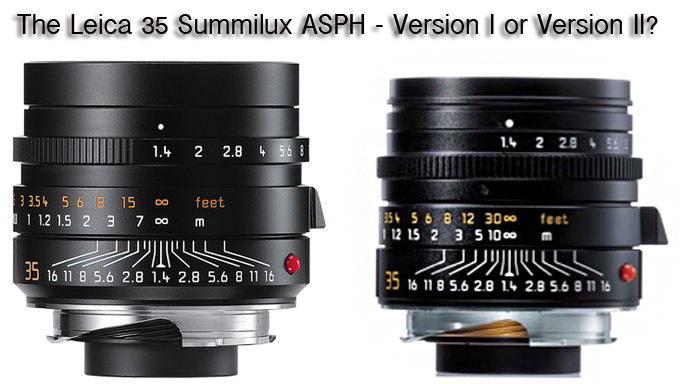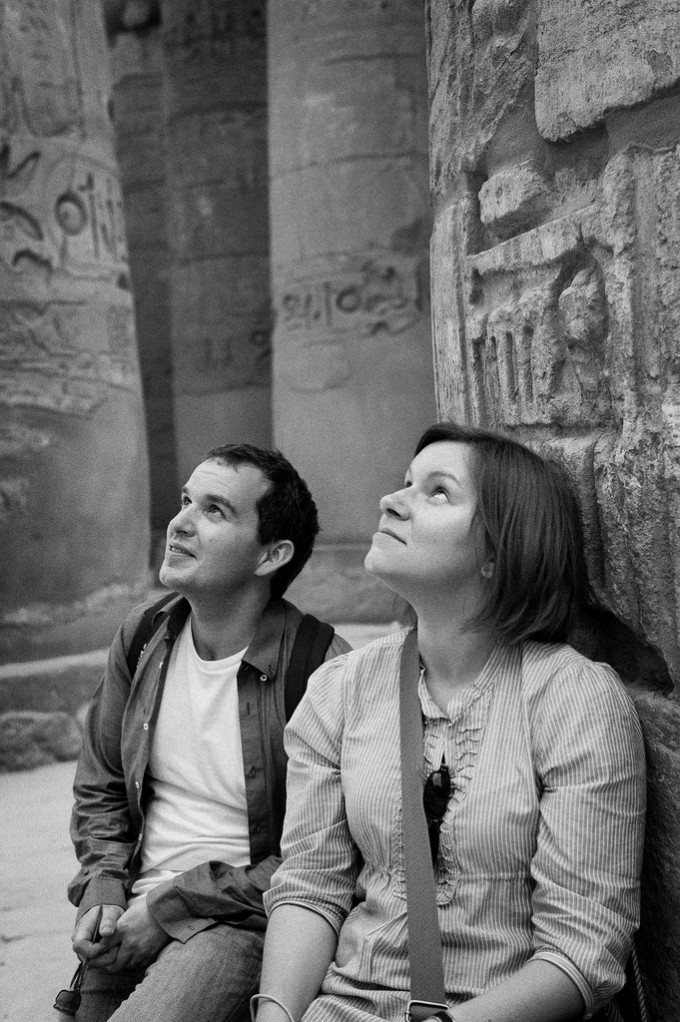35 mm Summilux ASPH: Which one should you have in your kit, version I OR version II?
By Ashwin Rao

(DISCLAIMER: Images taken with the version 1 35 mm Summilux ASPH were taken in a far more diverse set of circumstances over a 2 year period. Images taken with the Version 2 lens were taken over the past 2 weeks and are thus more limited in scope and subject matter.)
Hi, everyone. It’s Ashwin here again with a few comments on the new Leica Summilux 35 mm f/1.4 ASPH (version II), which I was recently able to purchase for use on the Leica M9. For those of you who don’t know, this is actually the THIRD aspherical design of this classic lens that Leica has produced, and it arrived here back in the summer of 2010 to much pomp and circumstances. The first version, popularly called the “35 mm Summilux Aspherical” (as “Aspherical” was written in full on the lens barrel), was produced in very limited numbers, and will not be discussed further here, as I have no experience with it; it’s really a collector’s item. The second version, the “Summilux 35 ASPH” was mass produced from the early 1990’s through 2009, and was a stellar performer. Steve reviewed the lens here. I will be calling this the “version 1 35 mm Summilux ASPH”, or “version 1” for short, as this is the first mass produced 35 mm Summilux lens with aspherical elements. It’s also the first that had “ASPH” scripted on the lens barrel. Finally, in 2010, after rumors had circulated for many months to years, Leica released the “version 2 35 mm Summilux ASPH”, and most reviews of this lens have been quite favorable. While the lens has been slow to arrive at least here in the U.S., increasing numbers of the lens have begun to arrive at reputable Leica dealers, and I was able to get mine just 2 weeks back. In order to purchase this lens, I had to sell my beloved version I, but in order to get something, you have to give something up.
Some of you might have read that the version 1 35 mm Summilux ASPH was my favorite lens for the M8 AND M9. That lens has a very unique rendering, both soft in its transitions in and out of blur, with a lively, yet controlled out of focus rendering, and is quite sharp. To me, this lens “speaks Leica” in its look, and blends the benefits of an aspherical design with the charm of more classic looks. When you nail focus with this, images can quite special, both wide open and stopped down.
One of the design limitations of the version 1 Summilux ASPH was the lack of a floating element, which is present in some newer designs such as the Summilux 50 mm f/1.4 ASPH. Floating elements are a mechanical design that theoretically reduces the risk of focus shift when an lens’ aperture is stopped down. “What the heck is focus shift?”, you might ask? Well, to be brief, it’s a phenomenon that occurs when a lens shifts its focus plane when its aperture is stopped down. For example, if a camera is mounted on a tripod and a focus point is chosen when the lens is shot wide open, stopping it down in aperture to f/2.8 through f/5.6 may result in a shift in the focus plane, and thus, you might end up with out-of-focus pictures. Focus shift DOES NOT account for the occasional situation when the photographer shoots the lens wide open (in this case, f/1.4) and gets an out of focus image despite lining things up correctly in the rangefinder viewfinder. That latter issue is more likely related to rangefinder misalignment or a lens that needs calibration (or both).
The Version I 35 mm Summilux ASPH was notorious for its focus shift, particularly between f/2.8 and f/5.6, and Steve himself was frustrated enough to sell off this lens due to this issue. My own copy of the version I lens never really seemed to demonstrate this issue, but maybe it is more related to the way I shoot and the inherent errors and compensations that I make when composing and capturing a photograph.
Leica ultimately acknowledged the focus shift issue present in the 35 Summilux ASPH Version I, and redesigned it by including a floating element in the version 2’s design. They have not to date made many (?any) claims, to my knowledge, that the optical elements are otherwise altered, but I could be wrong. Experts like Erwin Puts have in fact remarked that the 2 lenses have near identical MTF charts, suggesting that they are optically very similar. Other experts have note that the new version II design dramatically improves on the focus shift problem seen in the version I lens, though both lenses do in fact continue to show the focus shift effect.
I will let the experts be experts, but I wish to report my experience and observations between the 2 versions of the lens. In my eyes, the 2 lenses render images differently. Unfortunately, I do not have a head-to-head, image-to-image example to share with you, as I sold my version 1 to help pay for my version 2 lens.
So let me boil it down for you here…..
Version 1 35 mm Summilux Asph
The version 1 is a well-built lens, semi-compact, in size with a smooth focus throw and firm, yet silky aperture stops. In terms of build, its weakness, in my opinion, is its cumbersome hood and its reported focus shift. When attached, the hood does intrude into the viewfinder’s 35 mm frame lines. It takes a bit of adjusting to, but unlike the 35 mm Summicron f/2 ASPH, there is some viewfinder obstruction with this lens. Then, there’s the topic of focus shift. I never experienced dramatic focus shift with my copy of the version I lens, but plenty of others have, and the Leica forums are replete with discussions of this issue. My recommendation to you, in shopping for the version I lens, is to “try before you buy” with your own camera. An easy test is to achieve focus with the lens set wide open (f/1.4), and insure that the camera set in fixed position (i.e. tripod). Begin to stop down to f/2.8, f/4, and f/5.6 and take shots at each aperture. Download the images into whatever file management software (i.e. Lightroom or Aperture) you use. On the computer, you can easily soom in to see if the images are reliably over that focal length range. If this holds true, you have yourself a winner, and buy that with confidence.
In terms of rendering, the version I exhibits exemplary characteristics. While some have commented that it can be a high contrast lens, I find that its contrast is acceptable, and contrast can only get a bit high in very brightly lit, contrasty settting (midday sunlight in a forest, for example). Otherwise, it renders quite nicely, with a unique, dare I say creamy, bokeh, lovely focus to out-of-focus transitions, and a nice crispness, even when shot wide open. Bokeh is usually not “busy” or “nervous”, if such words can be used to describe it (obviously, bokeh is very dependent on the subject matter, lighting, etc). Can you tell that I like this lens? In my eyes, it was born to be a classic, and if it weren’t for the focus shift issue, Leica would probably never have needed to redesign it…
Until the introduction of the version II Summilux ASPH, most people looking for a 35 mm Leica lens would debate between the Version 1 Summilux ASPH lens and the Summicron 35 ASPH, which has a more clinical look that the Summilux. I feel that the Version I Summilux ASPH is a character lens (i.e. it gives your images a certain “look”, that may not strive for optical perfect but gives images a “personality”…I know this is all very subjective)….others may debate me on that, but this is my feeling.
Version 2 35 mm Summilux ASPH
Okay, all I can say is “Wow”. What a lens! Perfect, though? Uh…NOPE….Great? Uh, YUP! Okay, let me explain…
I have now had 2 solid weeks to shoot the beautiful new version 2 Summilux 35 mm f/1.4 ASPH. And I must say, it’s a outstanding performer. In terms of focus shift, this lens does not demonstrate this problem at all in the real world. Images focus spot on, every time, and images are rendered cleanly, sharply, and with higher contrast than the version 1 lens. In fact, I have felt that many Leica lenses exhibit some degree of focus shift, and this version 2 Summilux appears to demonstrate the lowest degree of focus of any lens I have used, save maybe the 50 mm Summilux ASPH, which matches it in terms of precision and performance. In some ways, the version 2 lens is a partner for the Summilux 50 mm f/1.4 asph, as their renderings are bit more consistent, in terms of micro-contrast, clarity, and macro-contrast. However, whereas the 50 mm Summilux ASPH renders a near perfect, clinical look with creamy bokeh, the 35 Summilux ASPH version 2 lens renders bokeh a bit more “wildly” and OOF is a bit more unpredictable. At times, especially, when there’s a lot of detail in areas where background is blurred, bokeh can be a bit busy, a bit “nervous” and a bit “energetic”…once again, all of this is subjective, but take it for what its worth. If you are looking for a lens that’s clinically perfect, I’d dare to say that the 35 mm f/2 Summicron will give you a cleaner, more clinical, “perfect” look, but here again, the 35 Summilux ASPH version II gives you more character, a certain je ne sais quoi…it puts its stamp on the image, and if you like that “stamp”, you’ll love this lens.
In my experience, the character of the version II Summilux ASPH is noticeably different than it’s version I counterpart, both optically and mechanically. The lens exhibits more contrast, and it renders images in focus with more clarity. As a result of this clarity and contrast, transitions in bokeh and from focused regions to OOF regions seem a bit more dramatic, and this can take some getting used to, when one is used to the version I’s look. I consider the look to be a mix of modern, with a touch of the classic creaminess, though the balance is shifted towards sharpness and clarity, and even further away from the “glow” of Leica lenses of old. Mechanically, the Version 2 lrnd has a smooth, non-stiff focus throw, and aperture stops are solid, yet not stiff (very similar to the Summilux 50 asph). The lens hood is a HUGE improvement over the prior version’s hood. Viewfinder obstruction is far less than in the version I, though I’d still say that about 1/5 (20%) of the viewfinder is obstructed by the hood. With the hood removed, viewfinder obstruction drops to less than 10 %. The only issue that I see with using the new hood is trying to cram in a UV filter to protect your lens’ front element. I use a Heliopan thin-cut UV MRC filter, and it has to literally jammed into the hood with force to get it in the right position so that the hood can still screw in appropriately into its thread lower along the lens barrel. However, once you have fit a UV filter in place (I’d strongly recommend a thin cut filter with a shallower metal ring, to allow proper fit), everything works well. Mechanically, the lens is a true pleasure to use. In terms of feel, the lens, with hood attached, feels substantially smaller than the version I lens, and in practical use, this size difference matters. Build quality is otherwise top notch, and there’s no element wobble or other sign of mechanical imperfection.
I suspect that as more people get their hands on this lens, it will become a lens with its fans and detractors. Leica is striving for a more modern look (i.e. suited for “digital”) in their lenses, and based on my experience with their modern lenses, these lenses exhibit more contrast and color saturation than their older counter parts….the Summilux Version 2 lens definitely belongs with its modern counter parts in this respect.
So let’s summarize, in terms of both pros and cons
Version 1 35 mm Summilux ASPH
Mechanically sound
Delicious, creamy bokeh
A character lens, equal parts classic and modern, with more gentle out-of-focus rendering and increased contrast in harshly-lit circumstances
The hood is imperfect, at best, and causes a fair amout of viewfinder obstruction
Some copies (if not all) exhibit focus shift, and this is substantially worse than the version II lens
Version 2 35 mm Summilux ASPH
No detectable focus shift (maybe the best lens for this that I own…)
Somewhat more contrasty than the prior lens, observable in more circumstances
A character lens. Bokeh can be beautifully creamy at times and “nervous” to “active’ at other times, with less predictability than the prior version
Mechanically outstanding, nearly perfect
The lens hood is a real winner, though it takes a bit of force to get a filter to fit right
It seems smaller than the prior asph version, mainly due to hood design
So which lens is the right one for you? Well, that’s a purely subjective decision. I am simply laying out my take, which is slightly different than Steve’s take. Will I be keeping this lens? HECK YEAH. If I had the choice to sell the version 1 lens again to get the version 2, would I do it again? Tough question, but the answer for now is “YES”. It’s my choice for a 35 mm lens on the Leica M9, because it blends sharpness, speed (wide aperture), build quality (perfection), and size (small enough for regular use. I am a fan of character lenses, and this one has definitely got it. The question remains whether you and your photography can accommodate it’s character and build into your own comfort zone. Once again, that’s your decision. I know I’ve made mine. The version 2 lens stays in my bag!
Thanks again for reading!
VERSION 1 Images
Version 2 Images
From Steve: Thanks Ashwin for your thoughts on both of these lenses. To see more from Ashwin be sure and visit his blog HERE. To see all of his other articles on this site, just search for his name in the search box at the top of the page! There are some great articles there!
[ad#Adsense Blog Sq Embed Image]
PLEASE HELP TO SUPPORT THIS SITE TO KEEP IT GOING AND GROWING! I CAN’T DO IT ALONE!
Remember, anytime you follow my links here and buy from B&H or AMAZON, this helps to keep my site going. If it was not for these links, there would be no way to fund this site, so I thank you in advance if you visit these links. I thank you more if you make a purchase! I have nifty search bars at the upper right of each page so you easily search for something at either store! I currently spend 10-14 hours a day working on this site and the only way that I can pay for it is with your help, so thank you! Currently my traffic has been increasing but my funds to pay for the site has been decreasing, so any help would be GREATLY appreciated!
Even if you buy baby food, napkins or toothpicks at amazon it helps this site, and you do not pay anything extra by using the links here. Again, you pay nothing extra by using my links, it is just a way to help support this site, so again, I thank you in advance ![]()
If you enjoyed this article/review, feel free to leave a comment at the bottom of this page and also be sure to join me on twitter or facebook! Also, you can subscribe to my feed at my subscribe page HERE and read these posts in your browser or news reader!
Also, the new forums are NOW OPEN on this site so get involved if you like! Thanks so much for visiting my site!




















Hi, Thanks for an interesting article, but frankly, your conclusions are very difficult to support just looking at pictures on our computer monitors. I have a good 27″ monitor and frankly if you jumbled up the pictures I could not tell the difference so easily. I realise some Leica owners consider the system like a religion, and any criticism is like committing blasphemy. However in spite of the very high cost of Leica equipment and lenses there are many complaints relating to problems of quality control. Leica equipment is fallible and relies on a marketing image of exclusivity and on the perpetration of a myth of a special picture quality. I know because I have several Leica cameras and lenses including the version 1 in the article. I would bet that if an article was written using several other makes of excellent lenses,(Nikon ,Canon Olympus etc) very few would be able to identify the equipment used. In case you feel this is a frivolous statement, some years ago, with my local professional photo dealer we tested a number of photographers to pick out the Leica pictures from the rest. The result was proving the point that a good picture is a good picture and a bad picture is a bad picture regardless of the system used.I love my Leica lenses, but am not convinced the are any superior to some of my other lens. I also have a Rolex but my vastly cheaper quarts watches keep better time!!!Thanks for the stimulating article.
Well I just read the review, very well done. No drama about the foucus shift. Again, I use flim with the M7. I have test for the shift and see none, I have heard people say it is more pronounced in digital cameras. All this being said, the floating element is controled by the foucus or by F stops? I am very old, billions of years ago I got my hands on new type of Nikon lens, it was a 24mm F2.8 lens with a floating rear element. That element was not for foucus shift, it was for sharper images when were in close, less the about two feet. Unless I see some great shift, if I go digital. I will keep my silver F 1.4 with it’s great lens shade.
I have a B+W 46mm UV filter on mine. It’s not even thin cut and it fits fine. It doesn’t interfere with the screw-on hood and costs less than $50 on Amazon.com. Just thought I’d chime in.
Hi Gene, thanks for your reply. What you said is news to me. Do you have the Pre-ASPH or the ASPH 35mm summilux?
Is your B+W the MRFC coated lens? I wonder if the ND filters will also work with the hood then. I hope you can respond.
Hey Jason, I have the Leica 11663, which is the newest Summilux Asph (or in Ashwin’s taxonomy, Version II). My filter is the B+W 46mm UVA (Ultra Violet) Haze MRC #010, model 66030559. It goes for $39 on Amazon. No idea if B+W ND filters would fit but I’d be interested to know as I can see using one. The lens is a thing of beauty and is tied with the latest Lux 50 as my favorite, but like any short, fast glass it can blow-out the occasional highlight, especially when the sun shines low and hard.
Lemme know if this helps.
Hi there Gene, yes it definitely does! I didn’t want to get the leica filter, would rather get the B+W. I’ve just read so many forums that the B+W filtere didn’t fit with the hood. Am glad to see you using it. I will see if I can get an ND filter and try it also.
How many stops are you looking to drop- 3?
Good question. Probably around 2, since I’m not looking for long exposures in daylight or any special effects. I just dislike “red” areas on my review screen (especially since they’re hard to make out on the M9 review screen).
🙂
Hi Ashwin, pleaes reply back if you can. Am surprised you were able to fit the “Heliopan thin-cut UV MRC filter”. I’ve read from other forums that only the Leica branded filters work.
I’d rather get the Heliopan because of the coating, and it’s cheaper. How “tight” was the Heliopan on the lens. Is this something worth doing if I want the coating?
The version 1 images seem more “3D” and less “graphic” (which is why to my eye they seem closer to the latest 50mm Summilux asph than do the version 2 shots).
The first shot in each set illustrates the difference. I’m guessing it would have been tough to get the first shot in the Version 1 photoset using the version 2 lens. It would seem equally tough to get the first shot in the Version 2 photoset using the version 1 lens.
3D versus graphic…
Excellent write-up!
Hi,
Please be aware that the focus shift on 35 Lux Asph I is only a problem on the black models.
On titanium and chrome, there is absolutely no focus shift issues.
That’s a common urban myth, but consensus is that the chrome/titan versions are less susceptible….not sure how thorough testing has been though….
Where can you find the new Lux? Looks like at least a 3 months wait the places I’ve asked!
Consider checking wiht Precision camera in Austin, Tx, and ask for Robert Jagiitsch….
Ashwin, thank you for that interesting article.
I’m currently thinking strongly to change to M9.
As I’m most comfortable with a 35mm I already was looking to ‘which’…
Regards Axel
I purchased version 2 and was not happy with the results, I liked the feeling of v1 better, however, my aspherical was by far the very best and I guess I will have to use this lens as my daily shooter.
Great article, Ashwin. It’s really good to know the differences between the lenses from a shooter’s point of view. I think that with either lens, you’ve reached an optical stratosphere where the differences are as much aesthetic as they are objectively “better” or “worse.”
It’s interesting that many of the “look” comparisons you make between the Ver2 vs. the Ver1 are very similar to the tradeoffs I see between my Ver1 ‘Lux ASPH vs. my Voigtlander 35/1.2, with the two ‘Luxes one notch further in the direction of a modern look. And like other commenters above, I’ve found that often the “better” a lens is, the harsher it can be. If one can cope with the focus shift, there are many reasons to keep the Ver1. And where one finds the sweet spot between classical rendering and modern clinical perfection is going to vary from person to person.
I recently took the Ver1 ‘Lux ASPH on a trip to Israel. It stayed on my M8 way more than my other focal lengths. I came back very, very happy–you’ve seen some of the photos. I’m not unloading either the Voigtlander 35/1.2 or my classic pre-Asph Summicron, though. Each one of these lenses has a particular set of tradeoffs, and it’s nice to match the lens to the circumstances.
Thanks again for a great article!
Peter, great to hear from you, and thank you so much! You are right that either lens deserves a hollowed place in someone’s lens lineup, and it’s a matter of aesthetics which is better (sort of like the debate between the 35 ‘cron IV and the 35 ‘cron asph)….
Your images from Israel were/are amazing! The 35 Lux asph 1 did great service for you!
Best,
Ashwin
I haven’t yet read any of the above comments, but here is my take:
DANG! The images from version 2 are MILES BETTER than version 1. This may have a little to do with your subject matter – but not *too* much.
Really, to my eye, Ver2 is vastly superior. By a long way.
Thanks for the article Ashwin.
Adam, Thanks. It’s funny, but I like the scope and tonal range of the version I better, myself, but the II has more POP! It’s so subjective these things, and it’s a struggle to decide from my standpoint.
Thanks for the kind words again!
Thanks for sharing.
When I saw the title of this page, I thought someone is going to deny lenses in the past but you didn’t =) And I appreciated your fair input.
I have both of the lenses for about a month now. And I have found similar feeling about these two lenses though I did not see V2 is much sharper than V1. At closer distance, I see V2 has a little bit more contrast.
It seems to be a much easier decision for me when compare to Summilux 75 vs. 75 Cron. To me, the Version 1’s bokeh is sometimes “busy” enough to my eye compare among 50 and 75luxes. Its probably just an inch or two before I call it “too busy” in some circumstances (eg. your 5th shot). If I guess right, the bokeh would seem to be quite busy if I see it at 75 to 100%. And from my experience, Version 2 could have been more clinical look with higher contrast but with a even busier bokeh.
I guess in optical design world, there is always a trade off. The more contrast you have the lesser creamy bokeh and vice versa. That is almost always true when I compare modern lenses to the lesser modern one.
I think I am quite happy with the V1. Contrast is high enough for me and there was little or no shift on my copy. Just as I prefer the old Noctilux than the new. I think for contrast, I can easily adjust it in PS but not really for bokeh not to mention if I would have the luxury of time to correct it in the PS.
Definitely! I was trying to be fair and as unbiased as possible, though I did spend the big bucks on the new lens, for sure. I agree that the 75 lux-cron debate is easier, as there is more that separates the lenses. It’s certainly always a trade off…
I think the most brilliant thought in this article by Ashwin, and one that really shows the depth of understanding he has for what photography is for those of us who grapple with the many photographic decisions and dillemas we must deal with to create the kinds of images we each want to create, is this.
“The question remains whether you and your photography can accommodate it’s character and build into your own comfort zone.”
That IS the question, Ashwin. Because this lens really puts its own visual stamp on the images of whomever will use it. Its look, is now YOUR look. For a photographer, that’s a major aesthetic decision one has to both process, hopefully with some objectivity, and accept.
The plusses are that one can look at seemingly mundane or borderline subject matter and shoot it knowing this lens might and should be expected to create a highly stylized and maybe even idealized image of that subject or object.
The minuses are that you’re going to constantly burdoned with looking at every little boring everyday thing you encounter wondering… should I? lol! Will this lens work some kind of painterly magic on this door knob? Etc.
But seriously, if you’re shooting this lens, you’ve got to be willing to own that look. Because you’re not getting away from it. Unless, of course you’re stopping it down … but do we even talk to people who stop down Summiluxes? 😉
Donald, you are too kind. Thanks so much.
Helo Ashwin
Really nice work with DOF in these photos, even on the screen you still see that glow. I love the lighting and rendering of the table shot, the water jug shine makes for a lovely composition. I see you travel a bit, do you use a tripod or is your work hand held?
Thank you for your contribution to this site.
Cheers Peter
Hi Peter,
I don’t use a tripod with my M system, other than in VERY rare instances…
Best,
Ashwin
The version 11 wide open reminds me a little of my pre-asph 35mm summilux,whereas Id trade up to the version 1 to get the less distracting bokeh I see no point for a film shooter in paying the extra for the 11.Also is the photo showing the two lenses accurate size wise?I didnt realise before that the 11 was bigger than the 1…….and when you consider that the pre-asph is a lot smaller than the 1 think Ill stay put.
Version II still has focus shift. The point of focus moves backwards (backfocuses) as the aperture closes. I know. I had one. Lenses that do not have this “feature” (Cv Nokton 35/1.2, Biogon 35/2) completely outperform the Summilux ASPH ver.2 in the centre of the frame.
Please also read Tim Ashley’s post here: http://www.l-camera-forum.com/leica-forum/1389186-post75.html
Cheers, Horea
Great review, Ashwin.
Question: My version of the 35/1.4 II has a very annoying clinking sound when I move the lens. Does your version experience the same?
No clicking for my lens that I can tell….by move the lens, which ring do you mean, or do you shake the lens and hear a click? I have no unusual clicks as far as I can tell, holding it here in my hand…
That’s good to hear, Ashwin. I hear loud clinkijg when I move/shake the lens – as if something within the lens is demaged. Will send it to Solms today. Thans for your help.
Hi, had the same issue. Any feedback from Solms yet?
Nice review, Ashwin.
Now I wan’t one!
Too bad that a local vendor to provide a delivery time of March-April 2011.
I am very sad about this….
Ashwin, nice write up. It saves me the headache to try to get a version II. For the unique oof rendering, I have version I and for the perfect clinical look, a cron 35 asph. The best of the “old” and “new’ Leica world. Looks as if version I could become a sought after classic.
Thanks! Sounds like you are set!
Hey Ashwin, as always great write up!!! You are doing magic with those lenses 🙂
FYI, I just recently acquired a Leica R 35/1.4 ROM and will change the mount to fit my also newly acquired Sony A850. It’s gonna be interesting to see how it would compare to both M 35/1.4 Version 1&2.
Thanks, Norman, and congrats on getting the 35 summilux R, which should be great on the sony! I would love to see some work with R lenses, as I haven’t really seen all that much…
My version 2 is indeed close to perfect, optically. No complaints, there – particularly as it is fully usable at f1.4.
However, I find it can be very “clinical” and, to my eye, it doesn’t do the wonderful things to the yellows and reds that my 1960’s 35mm Summicron V1 does.
Like many things in life, it’s a trade off.
Ashwin….good write up. Got my version 2 the other day. While in the store, I took a few shots that I’ve taken before with the version 1. The word “WOW” came out of my mouth when I saw the images. I took a few shots today and so far the bokeh has been pretty good…but I’ll be on the look out for those dramatic shifts.
I tried a B+W filter today and ran into the same problem where I would have had to jam the hood over the filter in order to make it fit. My dealer had a Leica filter in stock – but it was silver. Gave it a try and it fit like glove…. the black one is on it’s way to me as I write.
Ashwin: Just a quick note, if you use a Leica branded UV filter, the hood will fit better and not jam in with the filter. Silly, I know 🙂
Ah ha, great advise, Mattias!
Yes. I didn’t have any kind of desire to jam the lens hood over a Heliopan or B+W filter, I tried both. Was lucky that the shop had a Leica 46mm UVa (#13004) filter in stock. Expensive! But what else is new.
Good review, Ashwin. I don’t know anything about other versions of ‘Lux ASPHs, 35 or 50mm. Would love a 50mm ‘Lux. But I am inclined to feel that this lens renders an image far removed from the look of Leica photography from back in the days of the great Leica photographers. Whatever they were shooting.
This is a different kind of image and image making. You can generate some serious stock image inventory with a lens like this, I believe.
To what degree digital is impacting the classic vs. modern look, I hope to find out by shooting all my lenses, including this one, on my M7. If shooting with Tri-X and the new 35 ‘Lux still produces clinical tonality (that’s my word for it) especially with black & white, then I’ll know or have a better understanding of what’s going on. I’m going to shoot a very special lunch at the most prestigious country club in Los Angeles close to Christmas. The space overlooks the golf course with plenty of light. I’m going to load Tri-X in my M7 and shoot my 35 Summarit and the new ‘Lux on my M9. Shoot a couple rolls like that and then I’m going to swap them. I KNOW the Summarit produces classic looking images but if all the film comes back with a classic look then I’m going to be a very happy dude. As far as the bokeh goes, the lushness of the 50 ‘Lux is, for me, the standard, other than the Noctilux. But my flower shot on DPR has a very lush non-caffeinated look. (see below) So… you just learn to when and where to use this lens to produce the OOF areas that you want. Sometimes the pretty bokeh-candy lights, sometimes the dead lush velvety look of my flower image. Avoid busy backgrounds and you won’t get busy bokeh.
[img]http://1qsgwq.bay.livefilestore.com/y1ptnzcjl_MZoO3DctIHUOvviINYv4daFnRkqEsiC_JHTOS7NDpzGFxtyAkgvSYczGRrmR0ROg0F6s2UJdmTyWAPpEGV1e4tfGH/L1008230_950.jpg?psid=1[/img]
Donald, this shot is AMAZING, dare I say close to perfect in its construction, tonality. It’s subtle, yet there’s so much going on. Thank you for sharing it here!
Thank you, you’re too kind, Ashwin. Your images have inspired me to get out try stuff like this. Thank you.
Lucy, thank you for your kind words.
Frank, I agree that I had a late model Summilux v1, and it wasn’t big on focus shift either. Film is apparently more tolerant of shift in focus (or so I’ve read), but who knows…I think the new 35 lux v2 will be in general more consistent, while the older 35 lux, when on the mark, will really sing!
To my eyes, the V1 has more character than V2 from these images, the V2 is just like what Ashwin said in the review, more towards the perfect clinical than being a character lens but not quite there… Thank for the review Ash, Guess now I’ll have to call my dealer to hold up on my order, I definitely prefer the V1’s “character” over V2’s “perfection”.
I wouldn’t care about it’s focus shift since I can learn to compensate.
Hi Dave. I agree. The V1 is a keeper if focus shift is not a bother (or noticeable to you)…
Ashwin, can you link more samples shot with the new version lux? I would really appreciate it!
Sure:
http://www.flickr.com/photos/ashwinrao1/sets/72157625456875318/
German elves are terribly clever..they brought me the VI last year and it is a beauty wide open which was the reason i chose it over the 35mm f2 Summicron…Does the new VII have the same leica glow wide open?
Great work Ashwin..Thanks very much for your review..i always find your thoughts on leica to be spot on, imho at least.
Lucy
I bought my 35mm Summilux Ver I from Adorama last December just before Leica discontinued it. Probably one of the last Ver I Summiluxes made. Anyway, I haven’t noticed any real focus shift, but then again, I use it on my film M’s. Can’t afford an M9 yet. Great lens overall, especially at F1.4 where my copy is tack sharp. I don’t see myself trading in my lens for a Ver II anytime soon or ever for that matter.
Great article Ashwin…I look forward to reading your articles, as well as articles written by other guest writers.
Frank
Ashwin,
Great shots and article. I bought an excellent version 1 copy from Ken Hansen a while back and I love it except for that cheap lens hood. Question: does the new version 2 lens hood fit in the version 1 lens?
Btw, I recently did a shoot of a local cafe here using my MP and 35 Summilux:
http://tumblr.com/xrcye8icv
like you said, creamy and dreamy bokeh.
Hi John,
Thanks as well. Unfortunately, the version 2 hood will not fit on the version 1 lens, due to lens design deffrences. Thanks for the link. I’m about to check it out!
Hey Ashwin,
Nice review, have you and Steve hatched a deal with Santa Claus this year? I think he’s gonna be overloaded with Leica letters.
I hope those elves are busy working…
Thanks, Adam, Santa has been kind to me in the past, so hopefully, he can be kind to others this holiday season ; )
The Elves and Solms, my guess, have their hands full ; )
Mr Rao,
Thanks so much for another insightful review. It does seem though it’s rather like the gentleman that while viewing a line of NFL cheerleaders comments to a friend that he’d like to date the ugly one. I would gladly take either lens.
I appreciate the ability to read your reviews, glean from your experience and view your photos.
I look forward to your next post…thanks again!
Thank you, Curt. I agree that either lens is great and love the cheerleader analogy, as it is quite appropriate here. Can’t go wrong…;)
Can I ask you/Ashwin a question (apart from that one)? It is this. The more I read these reviews the more I realise that we are all completely obsessed by equipment and seem to forget what really matters: taking photographs. I am well down this slippery slope. I have a 24mm elmar and 35 ‘cron but now want a 50mm summilux for my M9 (all for street/reportage photography). Tell me seriously. Is this mad or is there really enough of a difference to justify both a 35 and a 50 mm? Bear in mind I could always crop the images taken with a 35mm to make them the equivalent of a 50 lens (yes, I know there is a different perspective and signature etc).
Steve, if this is the wrong place for this query just move it/delete it but I notice Ashwin refers to both a lot in his article and even describes the 35 and 50 ‘luxes as “partner” lenses (assuming I am correctly understanding him). My issue is, if you had just two or three lenses for an M9 what do you think of having both a 35 and a 50? Thanks guys.
Hi Jeremy,
I know it seems silly to have lenses that are close to each other in focal length, but I have a 35 and 50 and I use them both on my M9. Even though they are close in angle of view, I find there is enough difference in the spatial relationships to warrant having both. Heck, I just got rid of an old 90 for a new 75!
Roger
Roger, great to see you here.
35 and 50 sounds close, but there’s a noticeable difference. Whenever I shoot 35, photos of people will tend to be of the entire person but never much closer than the head + torso. I find it difficult to get a face only portrait with the 35. Yes, I suppose we could keep cropping, but at some point, I would lose resolution. Conversely, with the 50, I find it hard taking landscape (natural or urban) photos as I find myself having to step further and further back. If I had to pick just one, I’d go with 35. 🙂
I agree with what’s been said, that 35 and 50 are different enough to justify having both, should you have the funds….Cropping the images will still give you a difference in focal-length related perspetive, distortion, etc….
As for being partner lenses, I basically mean that the 2 would work well together in the field….in terms of signature, if you happen to pair 35 and 50 mm lenses as do I (typically wiht a 90 mm lens as well).
Best,
Ashwin
Both lenses seem great. I like the signature of both, and I would be satisfied for the rest of my life with either or a summicron. There is no reason to mention the limiting factor of price, but I know I have to stay in school a lot longer to get on of these.
Have you ever shot either of these on black and white film? I would love to see some real film work with one of these lenses.
Hi Nik,
I do have some of the version 1 on B&W, but would have to dig and then scan images….
Hey Ashwin, do you lower the contrast in your post processing? I really like what you do in post processing.
Hi Nick,
Not really. With the new asph lenses, I pretty much keep contrast settings where they are. Thanks for the kind words!
@Ashwin – thanks for the excellent article. Extremely informative. Now if I can just get some funds to get ANY Lux lenses … 🙂
BTW, you don’t happen to own a 21 Lux? How about an article about it? Steve wrote one a while ago. But I think he was using an M8. Would like to see an article about the 21 Lux and/or 24 Lux on the M9.
Armando, the 21 lux is unfortunately not in my lens lineup, though I’d love to try it out (Leica, do you hear me? hahah)….
Regardless, the 35 is a worthy addition to to Leica lineup. I have the 24 lux and may give that a spin in terms of writing an article! Great idea!
Congratulations Ashwin and glad you’re enjoying your new Summilux 35mm ASPH!
I got mine two weeks ago but only spent one afternoon with it before sending it back to Leica to fix a small mechanical problem; there was a bit of ‘play’ on the aperture ring where F1.4 clicks into place, with a neighbouring indentation and therefore a second point, very very close to 1.4 where the blades jump slightly out of position to effectively give F1.5
Call me a fuss bag, but considering what we pay for these things, I thought “mechanical perfection” shouldn’t be negotiable. As a result, I am really missing it and hopefully it won’t take too long to come back to me.
Although I didn’t have enough time to put it through it’s paces, with what little I did with it I liked what I saw.
@hatem, my lens has the EXACT same issue. I am very interested to hear how yours returns from surgery. Please keep us posted.
Thanks, Hatem! Sorry to hear about your bad experience. I think I read about it over at one of the forums….
I agree that Leica should do QI enough to not worry about this….
Actually, if you look at Steve’s video review of the lens you will see the exact issue demonstrated at 3:52 – and I’m pretty sure that it did not register with Steve. I showed this 1.4/1.5 phenomenon to my local Leica rep and he said it was “within tolerance” and not a fault.
Part of the frustration is not being able to discern an official Leica position so as to be able to conclude whether one’s lens has a fault or not.
Fortunately, the lens still takes amazing photos!
You’re right proy; I just saw the video and there is that same play on the aperture ring though we don’t see what the blades are doing.
I’m told by my dealer to expect to get a reference/job number from Leica in the next 10-12 days with which we can follow up on progress. I will update when I find out more or when I get it back with problem hopefully corrected.
Mine goes past 1.4. I’m starting to think everyone’s does. it doesn’t bother me.
Great write-up Ashwin. I made the move to the M9 about 3 months ago and have slowly been building up my lens “porfolio”. I now have the 50mm Summilux ASPH, 28mm Summicron ASPH and the 90mm Elmarit. A 35mm lens was next on my list! You seem to have almost every lens (including the the Noc!) 🙂 What’s in your bag these days?
Haha, Thanks, Erik. I wish I had every lens. I have a few, you are correct, and often move my lens collection forward by trading towards bigger purchases….
I wish I had every Leica lens to play with, but sadly, that’s not the case…the 28 cron, for example, is one that I briefly had but no longer do. It’s great, and I hope someday to have it again.
You have an outstanding set up, by the way! A near ideal 4 lens kit!
Ashwin, a visual side-by-side comparison of the two lenses’ optical qualities would indeed have been nice, as from your text I’m having a hard time figuring out the actual differences between the two IQ-wise. So in this sense, I find your article comes a bit short on its intended point, sadly.
Your pictures, especially those taken with v2, are wonderful, though.
Completely agreed. I would preferred to do a side-by-side, but that will remain for someone who possesses both of these lenses at once. I couldn’t do that, unfortunately. Thanks for the kind words!